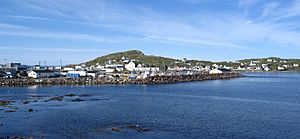Twillingate, Newfoundland and Labrador facts for kids
Twillingate is a charming town located on the Twillingate Islands, right off the coast of Newfoundland. It's often called the "Iceberg Capital of the World" because of the giant icebergs that float by its shores each spring. About 2,500 people call Twillingate home. This friendly community is famous for its beautiful views and warm welcome to visitors. Twillingate is about an hour and a half drive north of Gander and an hour north of Lewisporte.
The main way people in Twillingate make a living is through the fishery. Fishing has been important here for hundreds of years.
Contents
Discovering Twillingate's Location
Twillingate is found on two main islands, North Twillingate Island and South Twillingate Island. These islands are connected by a short causeway, which is like a small bridge. The town is part of the larger Newfoundland and Labrador province in Canada. Its location in the Atlantic Ocean makes it a perfect spot for seeing amazing marine life and icebergs.
How to Reach Twillingate
Getting to Twillingate is an adventure! Most visitors drive from other parts of Newfoundland. The drive offers stunning views of the coastline and forests. It's a popular spot for tourists who want to experience the unique culture and natural beauty of the island.
Nearby Towns and Cities
- Gander: A larger town with an airport, about 1.5 hours away.
- Lewisporte: Another coastal town, about 1 hour away.
- St. John's: The capital city of Newfoundland and Labrador, much further away, but a common starting point for trips to the island.
Twillingate's Rich History
Twillingate has a long and interesting history, going back hundreds of years. It was first settled by European fishermen, mostly from England, in the 17th century. Before that, Indigenous peoples like the Beothuk lived in the area. The town grew because of its excellent fishing grounds.
Early Settlers and Fishing
The first European settlers came to Twillingate for the rich cod fishing. They built small fishing stages and homes along the rocky shores. Life was hard, but the sea provided a living. Over time, more families arrived, and the community grew. Fishing traditions passed down through generations are still important today.
The Beothuk People
The Beothuk were the original inhabitants of Newfoundland. They lived off the land and sea, including the Twillingate area, for thousands of years. Sadly, their population declined after European contact, and they eventually disappeared. The story of the Beothuk is an important part of Newfoundland's history.
Demasduit: A Beothuk Woman
One famous Beothuk woman was named Demasduit, also known as Mary March. She was captured by Europeans in 1818 and later died. Her story helps us remember the Beothuk people and their connection to the land. There are efforts to learn more about their culture and history.
Economy: Fishing and Tourism
Twillingate's economy has always been closely tied to the ocean. While fishing is still very important, tourism has also become a big part of the town's life.
The Fishery Today
Today, the fishery in Twillingate includes catching different types of seafood. Cod fishing is still done, but crab and lobster fishing are also very important. Local fishermen use their boats to go out into the Atlantic waters. The fish they catch are processed and sold, supporting many families in the town.
Growing Tourism Industry
Twillingate has become a popular place for tourists. People come from all over the world to see the icebergs, watch whales, and enjoy the beautiful scenery. The town offers boat tours, hiking trails, and cultural experiences. Many local businesses, like guesthouses, restaurants, and craft shops, rely on tourism.
What Tourists Love to Do
- Iceberg Watching: In spring and early summer, huge icebergs float down "Iceberg Alley" right past Twillingate.
- Whale Watching: Many types of whales, like humpbacks and fin whales, can be seen feeding in the waters around the islands.
- Hiking: There are many trails with amazing views of the ocean and coastline.
- Local Culture: Visitors can enjoy traditional music, food, and stories from the friendly locals.
Images for kids
-
Map of Twillingate Islands
-
Portrait of Demasduwit (Mary March), by Lady Henrietta Hamilton, 1819, (Library and Archives Canada)





